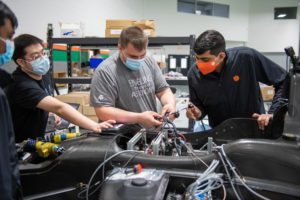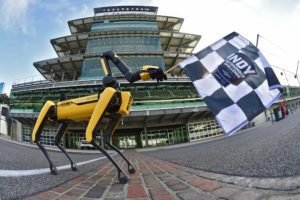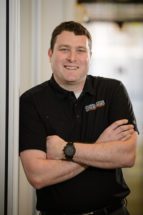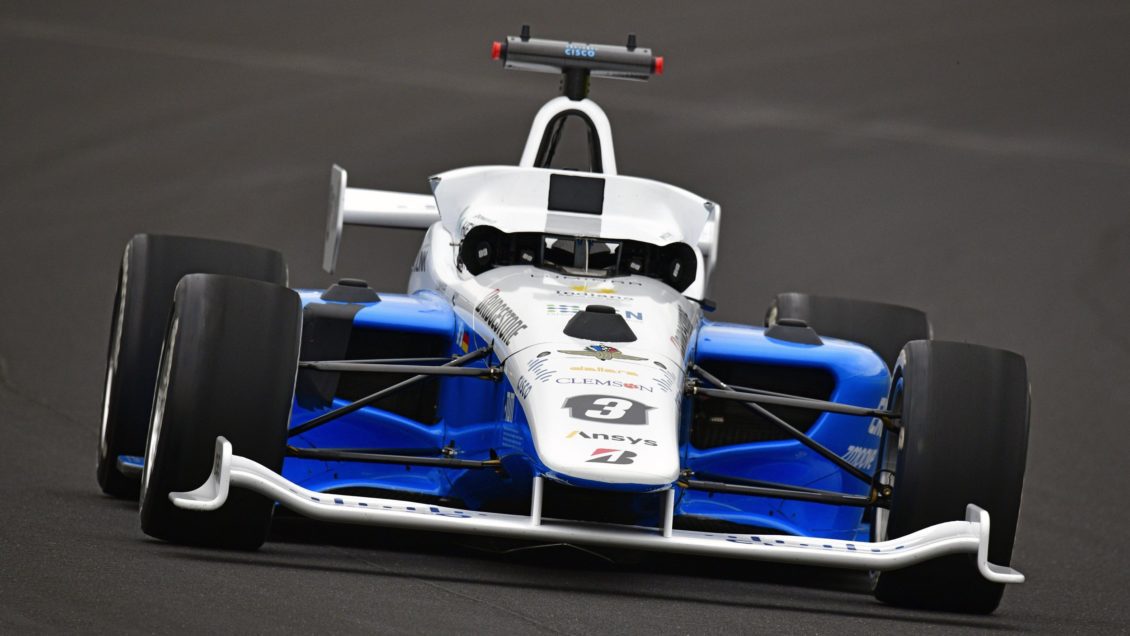It was an ambitious challenge to say the least.
Clemson University’s automotive engineers were tasked with designing an autonomous open-wheel race car and creating a prototype that would be reproduced, distributed to nine teams around the world and raced around a famed speedway, all in less than two years, as a pandemic sent much of the globe into quarantine.
And if that weren’t enough, those cars were supposed to be built to go 180 mph, fast enough to break the autonomous race car land-speed record.

If it was supposed to be impossible, the engineers must not have gotten the message. When the teams gathered Oct. 23 for the Indy Autonomous Challenge, it was a roaring success.
By the time a robotic dog waved the checkered flag, the event had shined an international spotlight on Deep Orange, Clemson’s vehicle design and prototyping program. Of the 39 master’s students who helped develop the race car, every single one went on to jobs in the automotive and robotics industries, or decided to pursue a doctorate.
“We set off to build this historic race car that could essentially break the land speed record at a famous speedway, but it was really about education,” said Rob Prucka, the Alan Kulwicki Professor of Motorsports Engineering at Clemson. “We wanted to focus on those 39 students and make sure that they had a great educational experience while they were here.”
Clemson didn’t have a team in the competition, but solid-orange engineering was infused in all the race cars that took the track on that cool, gray day at Indianapolis Motor Speedway.
Clemson’s involvement in the Indy Autonomous Challenge began in January 2020 when automotive engineering students and faculty began retrofitting a modified Dallara IL-15 race car with hardware, software and controls to enable autonomy. For over a year, they worked on their design and built a prototype at the Clemson University International Center for Automotive Research in Greenville.
The final product became known as Deep Orange 12, the latest creation in the celebrated Deep Orange program and the first in the program to go into production.
Once the prototype was finished and fine-tuned, the Clemson team worked with several companies, including Dallara, AutonomouStuff and Juncos Racing, which built identical race cars based on the Clemson design.

The race cars were distributed to nine teams from 21 universities around the world. Those teams then created algorithms to make them able to travel on their own without human drivers. For the competitors, the challenge was all about which team could write the best algorithms.
Amit Deshpande helped design the race car as a master’s student and decided to stay with Clemson automotive engineering after the project to pursue a Ph.D. Part of his job was figuring out where to place and mount sensors so they could withstand the intense speeds of racing. Deshpande also worked on other parts of the project, such as developing a low-cost powertrain package for the race car.
“It’s exhilarating to see the unique designs that have come out of the automotive engineering department and have been recognized around the world,” Deshpande said. “One of the things that I think gets ignored is that we achieved our goals within the time given. We were behind by six or seven months at one point due to COVID-19.”
The Clemson team faced some major headwinds almost right from the start. Two months into the project, everyone was sent home to quarantine as COVID-19 swept the globe.
To complete the design on time, the team mastered Zoom communication. Members started getting together to work in person as soon as allowed, sometimes pulling all-nighters.
Among those burning the midnight oil was Akshay Palakkal, who helped design the car as a master’s student, graduated in May and then continued to help as a Fellow with the Indy Autonomous Challenge.

“It was a big team effort,” said Palakkal, who now works for an electric-vehicle startup in the Los Angeles area. “A lot of sleepless nights were put into the project. We weren’t expecting more than 20 hours a week. But everyone wanted to make this thing happen, and we just pulled together. It’s amazing what happens when everyone puts in overtime.”
Janam Sanghavi said the most challenging part of the project was to deal with the complexity of modifying a traditional race car into an autonomous vehicle.
“As the program manager for Deep Orange12, I enjoyed working on coordinating the efforts of my team to integrate various perceptive sensors, drive-by-wire components and a cost efficient powertrain package,” Sanghavi said.
When race day arrived, the Clemson team got to see its work in action.
On and off the track, it was a celebration of cutting-edge technology. Boston Dynamics’ robot dog, Spot, waved the green flag, and Indiana Gov. Eric Holcomb helped start the race when he said, “Start your software and crank your engines!”
Matthias Schmid, a research assistant professor who helped lead the Clemson students, said seeing the race cars lined up in the pit lane, all at a slight angle, was an amazing experience.
“I could see the sensor design, and I could look at the lidars, the cameras and radars and the way we had designed them at Clemson,” Schmid recalled. “That was an amazing moment to see that it did work. For the first time in the history of Deep Orange, we built a production vehicle.”
The cars took the track one at a time for three hours. Prucka, a longtime race fan whose professorship is named for a late NASCAR driver, provided color commentary that was heard over the speedway’s public address system and broadcast to viewers tuning in for an online live stream.
Ripples of excitement spread for miles. Qilun Zhu, an assistant research professor who helped lead the Clemson students, caught the event online.
“The first time a team hit the track and passed the 100-mph barrier, that was really something,” he said. “Later, one team passed 150 mph, and that was mind blowing.”

No one broke the land speed record of 175 mph, set by the Robocar on a straight course in 2019, but the Indy Autonomous Challenge isn’t over yet.
Five teams from the challenge are planning to race on Jan. 7 at Las Vegas Motor Speedway as part of CES 2022. This time, the cars will compete head-to-head, all on the track at the same time.
The Clemson design could live on even after the Las Vegas race.
The innovations developed for the Indy Autonomous Challenge could eventually make their way into autonomous vehicles that travel public roads, similar to how technology developed for space exploration made it to everyday life on Earth.
“Things happen at the race– unexpected events are going to occur,” said Chris Paredis, who oversees the Deep Orange program and is the BMW Endowed SmartState Chair in Systems Integration at Clemson.
“At speeds of 180 and 185 miles per hour you better react very quickly and handle that situation safely. So we hope that the capabilities that are being developed in this race context will then be incorporated into consumer vehicles in the future. Enriched autonomy and making autonomy safe is going to be an important aspect.”
The winning team in Indianapolis was TUM Autonomous Motorsport from the Technische Universität München. The team recorded the fastest two-lap average speed, 135.944 mph, good enough to take home the $1-million grand prize.
To the Clemson team, the experience was priceless.
“The Indy Autonomous Challenge provided our students with an unparalleled experiential learning opportunity,” said Zoran Filipi, chair of the Department of Automotive Engineering at Clemson. “They had a chance to collaborate with multiple teams, including industry partners, on the cutting edge of sensing and autonomy, much as they would in a real-world setting. The whole team did a fantastic job of completing the vehicle on time despite major challenges.”
Anand Gramopadhye, dean of the College of Engineering, Computing and Applied Sciences, said Clemson’s role in the Indy Autonomous Challenge reaffirms that its automotive engineering program is one of the world’s best.
“This program shows the globe that the college’s faculty and students are working at the forefront of transportation, including in autonomy,” he said. “I congratulate the Deep Orange team. They are playing a key role in making the Indy Autonomous Challenge a major success, shaping the future of transportation and providing a workforce of the future. It’s a job well done.”
Get in touch and we will connect you with the author or another expert.
Or email us at news@clemson.edu

